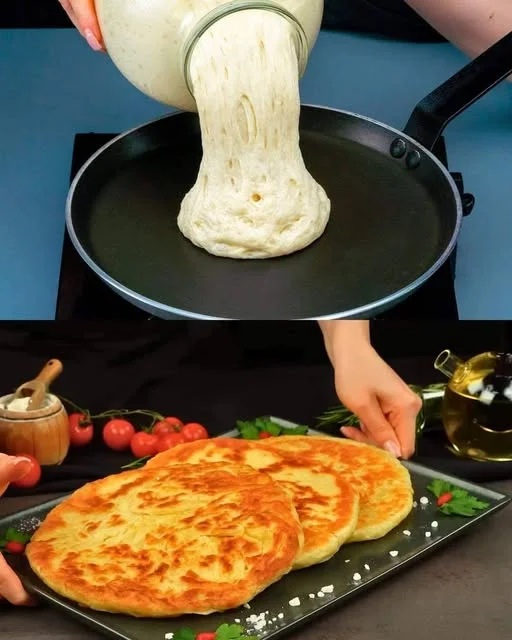A Lesson in Flavor from an Unexpected Place
Some of the most unforgettable recipes don’t come from fancy cookbooks or polished food blogs. Sometimes, they come from quiet moments, passed down over a counter, whispered from one cook to another with a twinkle in the eye and a bit of flour on the cheek.
Years ago, while traveling through a small town, I wandered into a modest neighborhood bakery. It smelled like childhood—yeast, butter, and something else I couldn’t quite place. The baker, an older man with a slow, practiced grace, noticed my curiosity. I asked him what gave his bread such a deep, savory aroma.
He smiled, cracked open one of the warm loaves, and revealed a swirl of chickpeas, garlic, and red bell pepper folded into the dough like a hidden treasure. “This,” he said, “is the trick I teach only to those who ask.”
He never gave me measurements. He didn’t write anything down. He just showed me—step by step—how something simple could become unforgettable. I went home, determined to recreate it. It took a few tries. But once I got it right, it became the kind of recipe that stops conversations and makes the whole kitchen smell like home.
Where Old-World Simplicity Meets Everyday Comfort
What makes this bread so special isn’t just the ingredients—it’s the intention behind it. It’s a humble dough, enriched slightly with milk and oil, nothing flashy. What transforms it into a showstopper is what’s hidden inside: a soft, buttery swirl of mashed chickpeas sautéed with garlic and red pepper.
It’s bread that feeds the soul.
The chickpea filling is rustic but brilliant. The texture is slightly creamy, the garlic adds warmth, the red pepper brings sweetness and color, and the butter ties it all together. When this mixture is layered into the dough and baked, the result is a golden loaf that’s tender, aromatic, and unlike anything most people have tasted.
It feels new, but it also feels old—like something your grandmother might have made if she had chickpeas and just the right kind of afternoon.
Ingredients Table
| Ingredient | Quantity | Notes |
|---|---|---|
| Warm water | 400 ml | Helps activate the yeast |
| Warm milk | 200 ml | Adds richness to the dough |
| Sugar | 10 g | Feeds the yeast |
| Vegetable oil | 30 ml | For moisture in the dough |
| Instant yeast | 8 g | For a quick and reliable rise |
| All-purpose flour | 850 g | Main structure of the bread |
| Soft butter | 150 g | Spread into dough before filling |
| Cooked chickpeas | 200 g | Slightly mashed for texture |
| Red bell pepper | 100 g | Finely chopped |
| Garlic | 4 cloves | Minced for aromatic depth |
| Salt | To taste | Adjust based on preference |
Directions
- Activate the Yeast: In a large bowl, mix the warm water, warm milk, sugar, and instant yeast. Let it rest for 5–10 minutes until frothy.
- Make the Dough: Add vegetable oil and gradually incorporate the flour while mixing. Knead for 8–10 minutes until you have a soft, elastic dough. Cover with a cloth and let it rise in a warm place for 1 hour.
- Prepare the Filling: While the dough is rising, sauté the garlic and chopped red bell pepper in a bit of oil until fragrant. Add the mashed chickpeas and cook for a couple of minutes. Season with salt and let cool.
- Shape the Dough: Punch down the risen dough and divide into equal portions. Roll each into a flat rectangle.
- Layer with Butter and Filling: Spread a thin layer of soft butter over the surface of the dough, then evenly distribute the chickpea filling on top.
- Roll and Shape: Roll up the dough tightly into logs. Shape as loaves, rolls, spirals, or your preferred style. Place on a parchment-lined or greased baking tray.
- Final Proof: Let the shaped dough rise again for 30–45 minutes until noticeably puffy.
- Bake: Bake in a preheated oven at 180°C (350°F) for 25–30 minutes, or until golden brown and cooked through.
- Cool and Serve: Allow to cool slightly before serving. Best enjoyed warm, but keeps well for 1–2 days at room temperature.
Nutritional Information (Per Serving – Approx. 1/12 of Recipe)
| Nutrient | Amount (Approx.) |
|---|---|
| Calories | 290 kcal |
| Protein | 7 g |
| Fat | 9 g |
| Carbohydrates | 42 g |
| Fiber | 3.5 g |
| Sugars | 1.5 g |
| Sodium | Varies (based on added salt) |
Why This Recipe Works So Well
1. A Soft Dough That Delivers
The base dough is enriched with both warm milk and a bit of oil, which ensures tenderness and elasticity. It’s soft to the touch and bakes up with a delicate crumb that’s perfect for soaking in flavor from the filling.
The combination of milk and water in the liquid base makes it more moist and rich than traditional lean doughs. This is essential when pairing it with a filling—you need structure, but you also need softness to let the layers melt together.
2. The Savory Filling That Surprises Everyone
Chickpeas may not be the first thing people expect to find inside bread, but once they taste this version, they’ll understand. Mashed slightly and sautéed with garlic and bell pepper, chickpeas become creamy, earthy, and hearty—without being heavy.
The peppers provide sweetness and freshness, balancing the richness of the butter. Garlic gives the entire loaf an irresistible aroma that wafts through the house while it bakes. Every bite becomes a layered experience of texture and taste.
3. The Buttery Binding Trick
Here’s where the baker’s wisdom really shines: before layering in the chickpea filling, you spread soft butter across the rolled-out dough. Not melted butter—softened. This little trick adds richness, but it also helps seal the dough, allowing the filling to stick and infuse each layer.
When baked, the butter creates just enough steam inside to puff the layers while binding the savory filling to the dough. The result is soft, layered perfection.
How to Serve It: Endless Possibilities
This bread is incredibly versatile. It’s satisfying enough to stand on its own but also plays beautifully alongside other dishes. Here are a few of the best ways to serve it:
- Fresh out of the oven with a drizzle of olive oil or tahini
- Sliced and served with a bowl of lentil soup or stew
- Grilled into a pressed sandwich with fresh greens and tomatoes
- Toasted and dipped into olive oil with za’atar or herbs
- As a hearty breakfast alongside eggs or shakshuka
You can even use the same dough and filling method to shape the bread into spirals, braids, or pull-apart rolls for entertaining.
The Nutrition Bonus: A Smart Indulgence
Yes, it’s delicious—but it’s also surprisingly nourishing.
Chickpeas bring fiber, plant-based protein, and complex carbohydrates to the table. They help keep you full longer and stabilize blood sugar, especially when combined with the slow-digesting starches in the bread.
Garlic and bell pepper contribute antioxidants and anti-inflammatory compounds, while the butter (used in moderation) adds flavor and richness without overwhelming the dish.
If you want to go a little lighter, you can use less butter or substitute a plant-based spread. But honestly? Sometimes a little real butter goes a long way in making a dish feel complete.
Frequently Asked Questions (FAQs)
Can I use canned chickpeas?
Yes, canned chickpeas work perfectly. Just rinse and drain them well before mashing. If you have dried chickpeas and time to soak and cook them from scratch, go for it—they’ll offer a firmer texture and richer flavor.
What kind of flour should I use?
All-purpose flour works beautifully and keeps the texture soft. You can substitute up to 30% of the flour with whole wheat for added fiber and a slightly nuttier flavor, though the bread will be a bit denser.
Can I make this dairy-free?
Yes. You can replace the milk with any unsweetened plant-based milk (like oat or almond milk) and use a dairy-free butter substitute or olive oil instead of butter. Just note that it may slightly change the richness.
Can I freeze it?
Absolutely. After baking and cooling, you can slice the bread and freeze it in a sealed bag for up to 2 months. Toast slices straight from the freezer, or reheat the whole loaf at 160°C (325°F) wrapped in foil.
Can I add other ingredients to the filling?
Yes! This recipe is wonderfully flexible. Try adding finely chopped spinach, caramelized onions, crushed chili flakes, or even sun-dried tomatoes. The chickpea base can handle a variety of flavor profiles.
How long does it keep?
Stored at room temperature in an airtight container or wrapped in foil, the bread stays soft for up to 2 days. For longer storage, refrigerate for up to 5 days and reheat before serving.
Can I shape it differently?
Definitely. You can bake it as one large loaf, divide the dough into mini loaves, twist it into a braid, or roll it into pinwheels for a more decorative presentation.
Why This Bread Deserves a Place in Your Recipe Collection
Not every bread needs to be airy and delicate. Sometimes, the best bread is the one that fills your kitchen with the smell of garlic, makes your family look up from their phones, and leaves your guests asking for seconds.
This chickpea-stuffed bread is humble and hearty—but deeply satisfying. It’s the kind of recipe that builds memories. A recipe that you can make with your kids on a rainy day. A recipe that carries tradition in a new form. A recipe that quietly becomes your go-to when you want to feed and comfort at the same time.
Conclusion: A Hidden Gem You’ll Want to Share
Some recipes come and go. Others stay with you because they speak to something deeper than taste—they speak to care, to effort, to creativity. This savory bread is one of those recipes.
Whether you’re a seasoned baker or a weekend kitchen adventurer, this loaf will surprise you. Not because it’s difficult. But because something so simple, so honest, and so practical can still taste so unforgettable.
Give it a try, and don’t be surprised if your family gathers around the kitchen before it’s even out of the oven. Just smile and say, “It’s a trick I learned from a baker.”
And now, you’ve learned it too.


